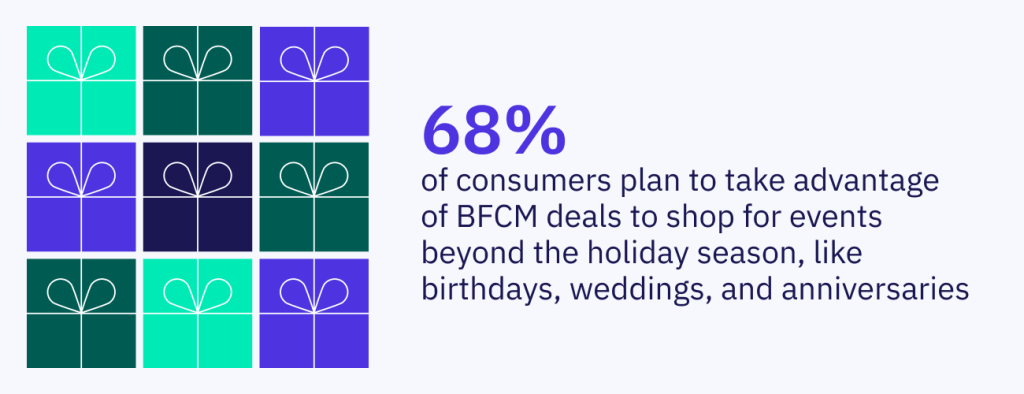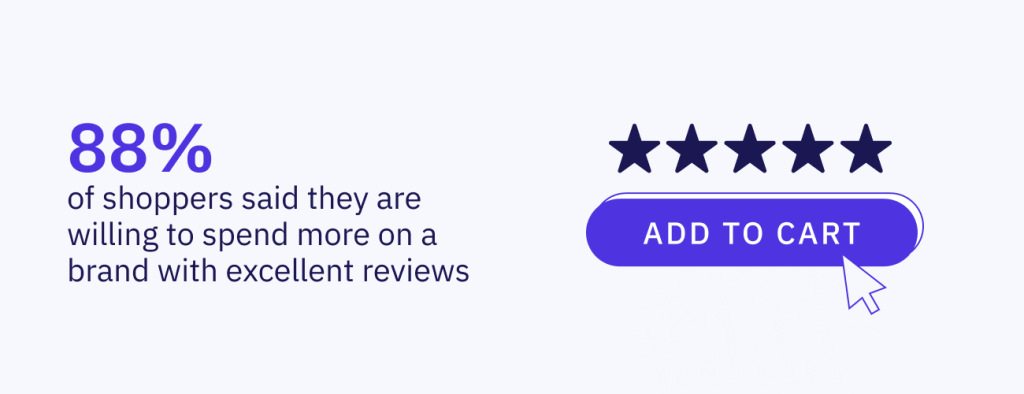
- Ecommerce Marketing
- Integration
- Partners
- Product
Supercharge Customer Engagement with Okendo & Klaviyo
Guest Author | Apr 21, 2025
Nov 15, 2022 | 9 minute read

Matt Goodman
Co-founder, CEO
With U.S. consumers spending close to $20B on ecommerce purchases across Black Friday and Cyber Monday in 2021, it would be fair to say that BFCM has become the Super Bowl for online retailers.
Historically, this has meant ecommerce brands finding the best way to captivate deal-seekers. And with consumers’ wallets under pressure this year from inflation, the value will likely be top of mind again for consumers. In fact, according to our recent Holiday Shopping Report, 23% of consumers say their budget for holiday shopping in 2022 is ‘much lower’ than in years past.
Based on that data point, it might seem intuitive for an ecommerce brand to take an all-or-nothing approach to create the best one-time offer for BFCM shoppers this year. However, a counterintuitive, long-term strategy for retaining your BFCM shoppers is needed to optimize all the benefits of this crucial shopping period. Our report also found that due to the current state of the economy, 68% of consumers plan to take advantage of BFCM deals to shop for events beyond the holiday season, like birthdays, weddings, and anniversaries.

That means this BFCM period could represent an even more significant opportunity than in years past to take advantage of the highest consumer engagement of the year to build and retain a larger customer base to ultimately drive more revenue. With that as a backdrop, we asked 7 ecommerce experts to weigh in on how to best turn BFCM shoppers into long-term, loyal customers, and here are their thoughts.
Rather than considering BFCM as a one-off event, online retailers must take a long-term view going in and out of the key holiday sales period. As Josh Garellek, CEO of Arctic Leaf, notes, “Retention and loyalty are key to consider going into the holiday period as well.” Rather than just thinking about offering deals in a silo, BFCM is the ideal time to “set up a long-tail nurture campaign based on past buying experience and preferences of current approaches,” he adds.
The same approach is needed once Cyber Monday has ended, as brands have the opportunity to forge relationships with those beyond shopping for the holidays. And relationships between brands and consumers cannot be overvalued. Our report findings indicate that 95% of consumers say that trust is a factor in deciding what brands they do business with.
BFCM is often the first opportunity to establish trust with consumers, which is a key ingredient in forging customer retention. Furthermore, to kick off a relationship, shoppers must have a good experience interacting with your ecommerce brand, even if they don’t complete a purchase. Prior research found that 33% of customers say they wouldn’t buy from a brand again after just one negative experience.
Those with a positive experience are more likely to convert into loyalty program members. Accenture has found that customers who belong to loyalty programs can generate 12-18% more incremental annual revenue growth. Furthermore, Bain and Company research illustrates that as little as a 5% increase in customer retention can increase revenue by 25-95%. Those numbers leave little doubt that your best customer is often your existing customers.
“These are all reasons for looking beyond day-to-day metrics such as Return On Ad Spend (ROAS) or average order value as the only way to measure BFCM success,” says Rachel Tyers, SVP of Strategic Partnerships at Okendo. “Online retailers should also incorporate long-term BFCM KPIs such as customer lifetime value.”
After adjusting your brand’s mindset to a long-term view with BFCM campaigns and creating a good first impression on the customers you aim to retain, it’s now time to capture data. While consumers are often willing to provide their contact information to receive special offers and promotions, that doesn’t mean it’s the only or best way to capture their information.
If a customer does make it through the purchase process and buys something during the BFCM period, the most beneficial data capture can occur post-purchase with a request for a review. Not only will it collect zero-party data that the customer willingly shares with the business, but it can also immediately fuel purchases from other consumers.
According to Jo Badenhorst, Marketing Executive at Blend Commerce, “You can also request shoppers to share pictures of the products they purchased while submitting reviews to get more user-generated content. Shopify apps like Okendo enable you to collect reviews with UGC and seamlessly add them to product pages, or even Facebook, to showcase how loved they are.”
Reviews provide the confidence that shoppers need to make informed purchases and also have a direct impact on a brand’s bottom line. 88% of shoppers in our recent survey said they are willing to spend more on a brand with excellent reviews.

To incentivize the collection of reviews, ecommerce brands can lean into loyalty programs. They can provide loyalty points whenever a consumer contributes a product review. Consumers are incentivized to offer an initial review and encouraged to return to the online store often to buy and review new products for further incentives.
In addition to capturing email, Brad McCrory, CEO of Knit Agency notes that for the younger demographic of consumers, it’s also vital to “capture phone numbers with SMS consent for receiving texts.”
A Klaviyo report from last year found that 85% of Americans report receiving texts from a brand today, and 65% are comfortable with it. The same report also uncovered that Millennials and Gen Zers preferred texts from brands the most. Therefore, when building loyalty programs among this younger subset of customers, SMS messaging can provide the exclusivity and personalized experiences they seek from their favorite brands.
Initial efforts to capture data from BFCM shoppers can’t be the only touch point with new customers. As brand trust becomes a bigger issue, consumers want to regularly engage and converse with the brands they are shopping from the most. Badenhorst believes that “Post BFCM sales emails should immediately inform new customers on discounts available on products they’re likely to love based on their initial purchase.” She explains that “Online retailers can also use the opportunity to share more about their brand and any extra information about upcoming promotions in the store for the new year.”
As Sanjay Ghataode, Founder & CEO at SeedCMS says, “This is the opportunity to turn new customers into regular customers. Therefore email flows, order confirmation emails, and SMS flows need to be in a good place with clear messaging to welcome customers aboard.”
The goal here should be rewarding BFCM shoppers for choosing your brand during the holiday shopping season by sharing additional offers or products that are customized for them. For instance, if a shopper just purchased a blouse, an online retailer could offer them a discount on a pencil skirt that compliments their recent purchase. However, it’s also important not to push consumers too hard with the follow-up sale. Illustrate that the brand will provide lasting value as they continue on their purchasing journey.
Taylor Payne, Partnerships Marketing Manager at Ambaum knows that “after the holiday season, customers experience shopping fatigue and often give their bank account time to rejuvenate.” She adds that “While you shouldn’t go cold, it’s good to keep communications post-holiday season specific to their BFCM journey. This could include reminding them of your brand’s mission, including some ‘commonly purchased with’ products, encouraging loyalty programs, and requesting for a follow of the brand on social channels.”
As time passes, a brand should actively seek new opportunities for the shopper to return. Sarah Gallagher, CEO of Sellry advises that over time, “Online retailers should give these converted BFCM shoppers reasons to come back and shop, such as discounts, subscriptions, and even new product drops.”
These conversations shouldn’t be limited to one-way communication via email and SMS. Ecommerce brands must create real-time feedback loops within their online store that facilitate back-and-forth conversations. In fact, Laurel Mintz, CEO of Elevate My Brand, believes “The most valuable way to build new loyalty programs and customer retention in the new year is by providing feedback loops with these BFCM customers to build new journeys based on their evolving needs and wants.”
One way to do just that is by using micro-surveys within Okendo Surveys. With Okendo Surveys, ecommerce brands can trigger micro-surveys with customers during peak levels of in-store engagement. These in-the-moment surveys provide a more reliable and effective customer feedback loop. By engaging customers when they are engaging with a product, the request feels more natural and less intrusive, making it more likely that customers will respond with more information on their current intent.
Ecommerce brands that capture and utilize zero-party data with customers onboarded during the holiday shopping period can drive more personalized and effective campaigns throughout the year. These campaigns can build stronger customer connections and scale businesses.
“Capturing data through real-time feedback loops allows you to offer the personalization you need in the future to segment customers and introduce new products and promotions throughout the year that cater to their style and interests,” adds Ghataode.
The more you engage with customers, the more enriched their customer profile becomes, which provides the preference and intent data needed to power more personalized and targeted experiences.
McCrory recommends that you also “Have a plan to retarget with post-holiday brand engagement and understand where your users are within their buyer journey.”
Reengaging customers with personalized communication around likely buying intent is vitally important, given data from Shopify indicates when an online retailer can entice a customer to return for a second time, their likelihood of purchasing again jumps to 45%.
Forward-thinking ecommerce brands are even weighing customers’ reviews and ratings into this personalized communication. Integrations with Okendo Reviews can enable online retailers to factor in what products a customer has given a positive or negative review for in the past to finetune the personalized messaging they receive.
Some online retailers may even want to take personalization a step further with gamification. Mintz believes that “Brands must think more about personalization and developing new and creative loyalty programs.” She adds, “This could be using things like NFTs or other web3 technologies.”
By adopting new technologies such as NFTs and other features such as badges, leaderboards, and loyalty program rankings, brands can provide further personalized experiences while motivating customers to compete with each other on their engagement.
This is just one more tool that ecommerce brands can add to their toolbox as they take a longer-term view with BFCM that engages value-driven shoppers and converts them into loyal customers.
Like this blog? Read more:
The BFCM Ecommerce Guide to Maximizing Opportunity
How to Host an Unrivaled BFCM Shopping Experience
Related articles
Ready to learn more?